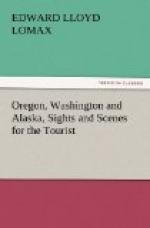Crater Lake is situate in the northwestern portion of Klamath county, Oregon, and is best reached by leaving the Southern Pacific Railroad at Medford, which is 328 miles south of Portland, and about ninety miles from the lake, which can be reached by a very good wagon road. The lake is about six miles wide by seven miles long, but it is not its size which is its beauty or its attraction. The surface of the water in the lake is 6,251 feet above the level of the sea, and is surrounded by cliffs or walls from 1,000 to over 2,000 feet in height, and which are scantily covered with timber, and which offer at but one point a way of reaching the water. The depth of the water is very great, and it is very transparent, and of a deep blue color. Toward the southwestern portion of the lake is Wizard Island, 845 feet high, circular in shape, and slightly covered with timber. In the top of this island is a depression, or crater—the Witches’ Caldron—100 feet deep, and 475 feet in diameter, which was evidently the last smoking chimney of a once mighty volcano, and which is now covered within, as without, with volcanic rocks. North of this island, and on the west side of the lake, is Llao Rock, reaching to a height of 2,000 feet above the water, and so perpendicular that a stone may be dropped from its summit to the waters at its base, nearly one-half mile below.
So far below the surrounding mountains is the surface of the waters in this lake, that the mountain breezes but rarely ripple them; and looking from the surrounding wall, the sky and cliffs are seen mirrored in the glassy surface, and it is with difficulty the eye can distinguish the line where the cliffs leave off and their reflected counterfeits begin.
Oregon National park.
Townships 27, 28, 29, 30, and 31, in Ranges 5 and 6 east of the Willamette meridian, are asked to be set apart as the Oregon National Park. This area contains Crater Lake and its approaches. The citizens of Oregon unanimously petitioned the President for the reservation of this park, and a bill in conformity with the petition passed the United States Senate in February, 1888.
* * * * *
Third Tour.—From Portland to Port Townsend, Seattle, and Tacoma.
WASHINGTON
Is 340 miles long by about 240 wide. The first actual settlement by Americans was made at Tumwater in 1845. Prior to this, the country was known only to trappers and fur traders. Territorial government was organized in 1853, and Washington was admitted as a State, November, 1889. The State is almost inexhaustibly rich in coal and lumber, and has frequently been called the “Pennsylvania of the Pacific Coast.” The precious metals are also found in abundance in many districts. The yield of wheat is prodigious. Apples, pears, apricots, plums, prunes, peaches, cherries, grapes, and all berries flourish in the greatest profusion. Certain it is that there is no other locality where trees bear so early and surely as here, and where the fruit is of greater excellence, and where there are so few drawbacks. At the Centennial Exposition, Washington Territory fruit-tables were the wonder of visitors and an attractive feature of the grand display. This Territory carried off seventeen prizes in a competitive contest where thirty-three States were represented.




